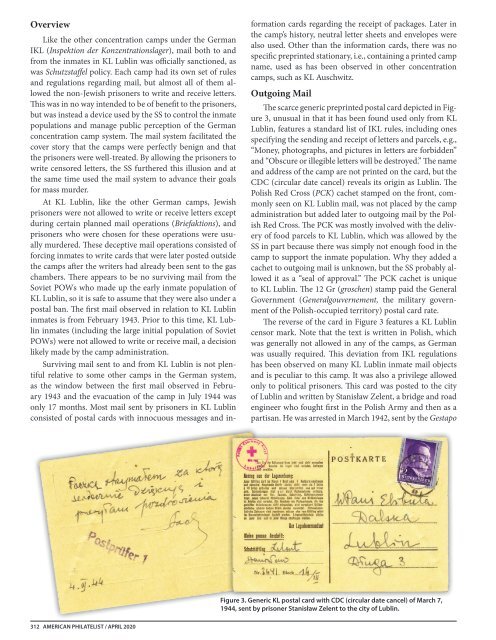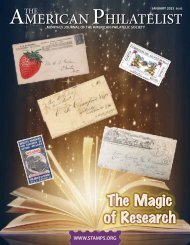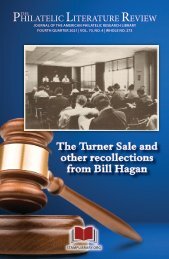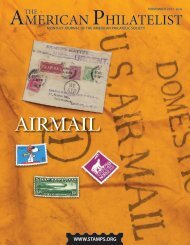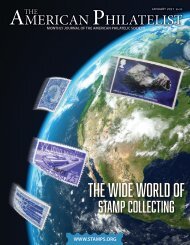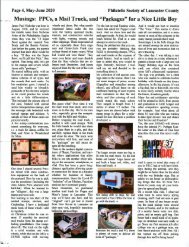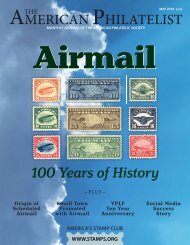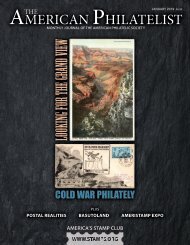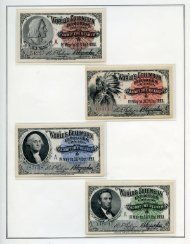The American Philatelist April 2020
Holocaust Rememberance Issue
Holocaust Rememberance Issue
Create successful ePaper yourself
Turn your PDF publications into a flip-book with our unique Google optimized e-Paper software.
Overview<br />
Like the other concentration camps under the German<br />
IKL (Inspektion der Konzentrationslager), mail both to and<br />
from the inmates in KL Lublin was officially sanctioned, as<br />
was Schutzstaffel policy. Each camp had its own set of rules<br />
and regulations regarding mail, but almost all of them allowed<br />
the non-Jewish prisoners to write and receive letters.<br />
This was in no way intended to be of benefit to the prisoners,<br />
but was instead a device used by the SS to control the inmate<br />
populations and manage public perception of the German<br />
concentration camp system. <strong>The</strong> mail system facilitated the<br />
cover story that the camps were perfectly benign and that<br />
the prisoners were well-treated. By allowing the prisoners to<br />
write censored letters, the SS furthered this illusion and at<br />
the same time used the mail system to advance their goals<br />
for mass murder.<br />
At KL Lublin, like the other German camps, Jewish<br />
prisoners were not allowed to write or receive letters except<br />
during certain planned mail operations (Briefaktions), and<br />
prisoners who were chosen for these operations were usually<br />
murdered. <strong>The</strong>se deceptive mail operations consisted of<br />
forcing inmates to write cards that were later posted outside<br />
the camps after the writers had already been sent to the gas<br />
chambers. <strong>The</strong>re appears to be no surviving mail from the<br />
Soviet POWs who made up the early inmate population of<br />
KL Lublin, so it is safe to assume that they were also under a<br />
postal ban. <strong>The</strong> first mail observed in relation to KL Lublin<br />
inmates is from February 1943. Prior to this time, KL Lublin<br />
inmates (including the large initial population of Soviet<br />
POWs) were not allowed to write or receive mail, a decision<br />
likely made by the camp administration.<br />
Surviving mail sent to and from KL Lublin is not plentiful<br />
relative to some other camps in the German system,<br />
as the window between the first mail observed in February<br />
1943 and the evacuation of the camp in July 1944 was<br />
only 17 months. Most mail sent by prisoners in KL Lublin<br />
consisted of postal cards with innocuous messages and information<br />
cards regarding the receipt of packages. Later in<br />
the camp’s history, neutral letter sheets and envelopes were<br />
also used. Other than the information cards, there was no<br />
specific preprinted stationary, i.e., containing a printed camp<br />
name, used as has been observed in other concentration<br />
camps, such as KL Auschwitz.<br />
Outgoing Mail<br />
<strong>The</strong> scarce generic preprinted postal card depicted in Figure<br />
3, unusual in that it has been found used only from KL<br />
Lublin, features a standard list of IKL rules, including ones<br />
specifying the sending and receipt of letters and parcels, e.g.,<br />
“Money, photographs, and pictures in letters are forbidden”<br />
and “Obscure or illegible letters will be destroyed.” <strong>The</strong> name<br />
and address of the camp are not printed on the card, but the<br />
CDC (circular date cancel) reveals its origin as Lublin. <strong>The</strong><br />
Polish Red Cross (PCK) cachet stamped on the front, commonly<br />
seen on KL Lublin mail, was not placed by the camp<br />
administration but added later to outgoing mail by the Polish<br />
Red Cross. <strong>The</strong> PCK was mostly involved with the delivery<br />
of food parcels to KL Lublin, which was allowed by the<br />
SS in part because there was simply not enough food in the<br />
camp to support the inmate population. Why they added a<br />
cachet to outgoing mail is unknown, but the SS probably allowed<br />
it as a “seal of approval.” <strong>The</strong> PCK cachet is unique<br />
to KL Lublin. <strong>The</strong> 12 Gr (groschen) stamp paid the General<br />
Government (Generalgouvernement, the military government<br />
of the Polish-occupied territory) postal card rate.<br />
<strong>The</strong> reverse of the card in Figure 3 features a KL Lublin<br />
censor mark. Note that the text is written in Polish, which<br />
was generally not allowed in any of the camps, as German<br />
was usually required. This deviation from IKL regulations<br />
has been observed on many KL Lublin inmate mail objects<br />
and is peculiar to this camp. It was also a privilege allowed<br />
only to political prisoners. This card was posted to the city<br />
of Lublin and written by Stanisław Zelent, a bridge and road<br />
engineer who fought first in the Polish Army and then as a<br />
partisan. He was arrested in March 1942, sent by the Gestapo<br />
Figure 3. Generic KL postal card with CDC (circular date cancel) of March 7,<br />
1944, sent by prisoner Stanisław Zelent to the city of Lublin.<br />
312 AMERICAN PHILATELIST / APRIL <strong>2020</strong>


